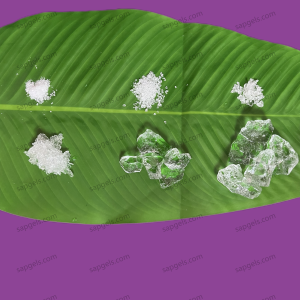What is Potassium Polyacrylate?
Potassium Polyacrylate is a type of superabsorbent polymer (SAP) known for its exceptional capacity to absorb and retain water. It is the potassium salt of polyacrylic acid, typically found as a white, granular, or powdery material. Its unique properties make it highly useful in various applications, particularly in agriculture.

Chemical Composition and Structure
The chemical formula for potassium polyacrylate is (C3H3KO2)n(C_3H_3KO_2)_n(C3H3KO2)n. It consists of long chains of polyacrylic acid with potassium ions neutralizing the acid groups. This structure creates a network that can trap and hold water molecules efficiently.
Mechanism of Action
Potassium polyacrylate absorbs water through osmosis. When exposed to water, the polymer’s network structure expands as it absorbs the liquid, retaining it within. This absorption capacity can range from 100 to 1,000 times the polymer’s own weight, depending on the specific formulation and environmental conditions.
Primary Uses of Potassium Polyacrylate
- Agricultural Applications:
- Water Retention in Soil: Potassium polyacrylate is extensively used to enhance soil’s water retention capabilities. This reduces irrigation frequency and improves water use efficiency, which is especially advantageous in dry areas.
- Drought Resistance: It helps plants endure dry spells by providing a steady moisture supply.
- Soil Improvement: By increasing the soil’s ability to hold water, it supports better plant growth, leading to higher crop yields and reduced water stress.
- Horticulture and Landscaping:
- Potted Plants: Adding potassium polyacrylate to potting soil reduces the need for frequent watering.
- Lawns and Gardens: It ensures that plants have adequate water, maintaining lush lawns and vibrant gardens.
- Industrial and Commercial Uses:
- Absorbent Products: Its high absorbency makes it ideal for use in diapers, sanitary napkins, and other personal hygiene products.
- Liquid Waste Management: It is used to solidify and manage liquid waste in various industrial processes.
Environmental Impact and Safety
Potassium polyacrylate is generally regarded as safe and non-toxic for agricultural and horticultural use. It is biodegradable, breaking down into water, carbon dioxide, and potassium, all of which are naturally occurring substances. However, it is important to use it as directed to prevent potential soil imbalances due to excess potassium.
Advantages of Using Potassium Polyacrylate
- Water Conservation: Reduces the need for frequent irrigation, conserving water.
- Enhanced Plant Growth: Provides a consistent moisture supply, improving plant growth and crop yields.
- Cost Savings: Lowers water consumption and irrigation costs.
- Sustainability: Supports sustainable agricultural practices by optimizing water usage.
Conclusion
Potassium polyacrylate is a powerful superabsorbent polymer with numerous applications, especially in agriculture and horticulture. Its ability to significantly improve soil water retention makes it a valuable resource for water conservation and plant growth enhancement. Responsible use of potassium polyacrylate can maximize its benefits while minimizing potential environmental impacts, making it an essential tool for modern agriculture and horticulture.

